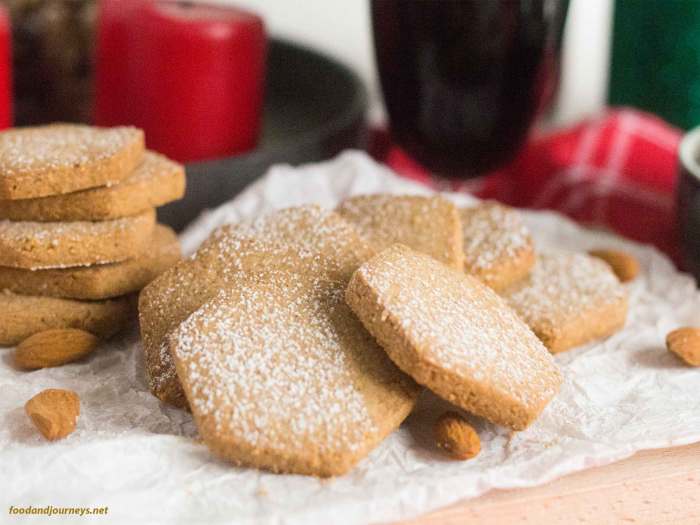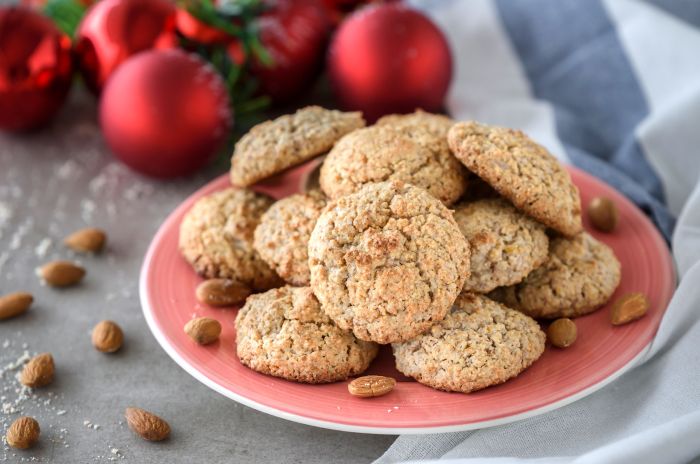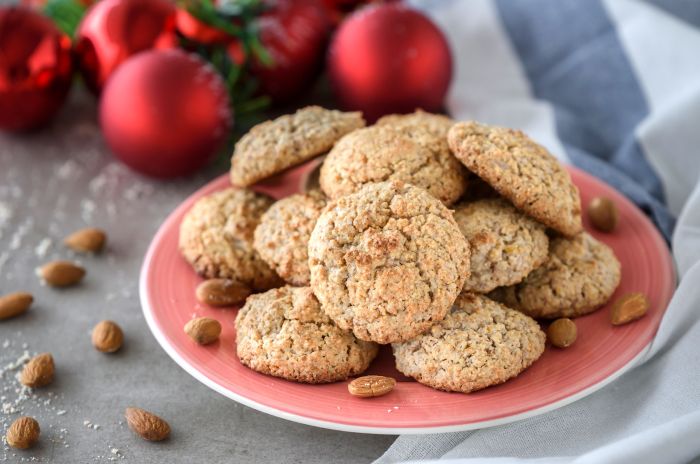Embark on a delectable journey into the world of Spanish biscuits, where tradition and innovation intertwine to create a symphony of flavors. These beloved treats have played an integral role in Spanish cuisine for centuries, capturing hearts with their unique textures, rich aromas, and captivating stories.
From their humble origins to their modern interpretations, Spanish biscuits have evolved alongside the country’s culinary landscape, showcasing a diverse array of ingredients, techniques, and regional influences. Join us as we delve into the enchanting world of these delectable delights, exploring their historical roots, key ingredients, popular variations, and the creative innovations that keep this culinary tradition vibrant.
Historical Origins
Spanish biscuits, known as “galletas” in Spanish, have a rich and storied history that dates back centuries. Their origins can be traced to the Middle Ages, when Arab traders introduced sugar and spices to the Iberian Peninsula. These ingredients were quickly incorporated into local baking traditions, leading to the creation of sweet and savory biscuits that became popular throughout Spain.
During the Age of Exploration, Spanish conquistadors brought these biscuits with them to the Americas, where they became a staple food for both colonists and indigenous populations. Over time, Spanish biscuits evolved to incorporate local ingredients and flavors, resulting in the diverse array of varieties that exist today.
Cultural and Culinary Significance
Spanish biscuits hold a special place in Spanish culture and cuisine. They are often served as a snack or dessert, and they are also used as a base for various pastries and cakes. In some regions of Spain, such as Andalusia, biscuits are a traditional part of religious festivals and celebrations.
Beyond Spain, Spanish biscuits have gained popularity around the world. They are particularly well-known in Latin America, where they are often enjoyed as a sweet treat or as an accompaniment to coffee or tea.
Key Ingredients and Variations
Spanish biscuits are characterized by their unique blend of flavors and textures, achieved through a combination of essential ingredients. These ingredients contribute to the distinct characteristics that set Spanish biscuits apart from other varieties.
The most common ingredients used in Spanish biscuits include:
- Flour:Typically, wheat flour is used, providing the base structure and texture of the biscuit.
- Sugar:Granulated sugar adds sweetness and caramelizes during baking, creating a golden-brown exterior.
- Eggs:Eggs act as a binder, helping to hold the ingredients together and contributing to the biscuit’s richness.
- Butter or Lard:These fats add flavor and create a flaky texture when incorporated into the dough.
- Flavorings:Various flavorings, such as cinnamon, anise, or lemon zest, are often added to enhance the taste of the biscuits.
Beyond these essential ingredients, Spanish biscuits exhibit diverse regional variations that reflect the culinary traditions of different parts of the country. These variations include:
Polvorones
- Originating from Andalusia, Polvorones are crumbly biscuits made with a combination of flour, sugar, almonds, and cinnamon.
Rosquillas
- Popular in Madrid, Rosquillas are ring-shaped biscuits flavored with anise and coated in sugar.
Carquiñolis
- Hailing from Catalonia, Carquiñolis are almond-shaped biscuits made with almonds, flour, sugar, and egg whites.
Mantecados
- Originating from Estepa, Mantecados are soft and crumbly biscuits made with lard, flour, sugar, and cinnamon.
Alfajores
- A traditional Andalusian treat, Alfajores are two round biscuits sandwiched together with a dulce de leche filling.
These regional variations showcase the rich diversity of Spanish biscuits, each offering unique flavors and textures that reflect the culinary heritage of their respective regions.
3. Popular Types of Spanish Biscuits
Spanish biscuits encompass a diverse range of delectable treats, each boasting its own unique flavor profile, texture, and appearance. These biscuits are deeply rooted in Spanish culinary traditions and have gained immense popularity both within Spain and beyond its borders.
Polvorones
Polvorones are renowned for their crumbly texture that literally translates to “powdery” in Spanish. These biscuits are typically made with flour, sugar, almonds, and cinnamon, resulting in a delicate and melt-in-your-mouth experience. Their appearance is characterized by a dusting of powdered sugar, giving them a delicate and elegant finish.
Rosquillas
Rosquillas, meaning “little rings” in Spanish, are a popular choice for breakfast or as a sweet treat. They are made with a dough that includes flour, sugar, eggs, and aniseed, and are often coated in a sugar glaze or cinnamon.
Rosquillas are known for their slightly chewy texture and sweet, flavorful taste.
Galletitas de Mantequilla
Galletitas de Mantequilla, or butter cookies, are a classic Spanish biscuit that is enjoyed by people of all ages. These cookies are made with a simple dough that includes flour, sugar, butter, and vanilla extract. They are characterized by their golden-brown color and a buttery, melt-in-your-mouth texture.
Maria Cookies, Spanish biscuits
Maria Cookies are a type of digestive biscuit that is widely consumed in Spain and other countries. These biscuits are made with a dough that includes flour, sugar, vegetable oil, and salt. They are known for their round shape, slightly crunchy texture, and a mild, slightly sweet flavor.
Bizcochos
Bizcochos are a type of sponge cake that is popular in Spain. These cakes are made with a batter that includes flour, sugar, eggs, and baking powder. They are characterized by their light and airy texture and can be enjoyed plain or filled with various fillings such as cream, chocolate, or fruit.
4. Traditional Spanish Biscuit Recipes
Immerse yourself in the rich culinary heritage of Spain through these authentic biscuit recipes. Each one captures the essence of traditional Spanish baking, promising a delightful treat that transports your taste buds to the heart of the Iberian Peninsula.
Polvorones
- Ingredients:
- 1 cup (120g) plain flour, sifted
- 1/2 cup (100g) icing sugar, sifted
- 1/2 cup (113g) butter, softened
- 1/4 teaspoon (1.5g) ground cinnamon
- 1/4 teaspoon (1.5g) ground nutmeg
- Instructions:
- Preheat oven to 350°F (175°C).
- In a large bowl, combine the flour, icing sugar, cinnamon, and nutmeg.
- Add the butter and use your fingertips to work it into the flour mixture until it resembles coarse crumbs.
- Form the dough into a ball, wrap it in plastic wrap, and refrigerate for at least 1 hour.
- On a lightly floured surface, roll out the dough to a thickness of about 1/4 inch (0.6 cm).
- Use a cookie cutter to cut out shapes from the dough.
- Place the biscuits on a baking sheet lined with parchment paper.
- Bake for 10-12 minutes, or until the edges are lightly browned.
- Let the biscuits cool on the baking sheet for a few minutes before transferring them to a wire rack to cool completely.
5. Modern Interpretations and Innovations

Modern Spanish biscuit makers are constantly innovating and adapting traditional recipes to contemporary tastes. They are experimenting with new ingredients, flavors, and techniques to create modern twists on classic biscuits.
Use of New Ingredients
One of the most noticeable trends in modern Spanish biscuit making is the use of new ingredients. For example, some bakers are using whole wheat flour, rye flour, or even almond flour to create healthier and more flavorful biscuits. Others are adding fruits, nuts, and spices to their dough to create unique and delicious flavor combinations.
New Flavors
Modern Spanish biscuit makers are also experimenting with new flavors. Some are creating biscuits with savory flavors, such as cheese, herbs, and olives. Others are creating biscuits with sweet flavors, such as chocolate, fruit, and caramel.
New Techniques
Modern Spanish biscuit makers are also using new techniques to create their biscuits. For example, some bakers are using sourdough starters to create biscuits with a more complex flavor and texture. Others are using laminating techniques to create biscuits with a flaky and buttery texture.
6. Spanish Biscuit Pairing Suggestions
Spanish biscuits offer a delectable treat that can be enjoyed in various ways. Pairing them with suitable beverages, accompaniments, and other food items can further enhance their flavors and textures.
Beverages such as coffee, tea, or hot chocolate complement the sweetness and richness of Spanish biscuits. The warmth of the beverages balances the crispiness of the biscuits, creating a harmonious experience. Additionally, the caffeine in coffee and tea can provide a stimulating contrast to the sweetness of the biscuits.
Spanish biscuits are a delicious and popular treat that can be enjoyed by people of all ages. If you’re looking for something to do in Chesterfield, be sure to check out the many shops and restaurants that sell these tasty treats.
You’ll find a wide variety of flavors and styles to choose from, so you’re sure to find something that you’ll love. After you’ve had your fill of Spanish biscuits, be sure to explore the many other things that Chesterfield has to offer.
From historical landmarks to outdoor activities, there’s something for everyone in this charming town. Click here to learn more about the many things to do in Chesterfield.
Accompaniments
Accompaniments like cheese, fruit, or honey add extra layers of flavor and texture to Spanish biscuits. Hard cheeses, such as Manchego or Parmesan, offer a salty contrast to the sweetness of the biscuits. Soft cheeses, such as Brie or Camembert, provide a creamy richness that complements the crispiness of the biscuits.
Fresh fruits, such as grapes or berries, add a refreshing sweetness and acidity that balances the flavors. Honey drizzled over the biscuits enhances their sweetness and provides a viscous texture.
Other Food Items
Spanish biscuits can also be paired with other food items to create a more substantial meal or snack. For example, they can be served alongside salads, soups, or stews. The sweetness of the biscuits can provide a contrast to the savory flavors of these dishes.
Additionally, the biscuits can be used to create sandwiches or wraps, adding a crispy element to the meal.
7. Health and Nutritional Information
Spanish biscuits vary in their nutritional value depending on the specific ingredients used and the preparation methods employed. However, in general, they tend to be relatively high in calories and carbohydrates due to their flour and sugar content.
The macronutrient breakdown of Spanish biscuits typically consists of a high proportion of carbohydrates, followed by moderate amounts of protein and fat. The calorie content can range from around 150 to 300 calories per serving, depending on the size and type of biscuit.
Potential Health Benefits
Some Spanish biscuits may offer certain health benefits due to the inclusion of specific ingredients. For example, biscuits made with whole-wheat flour provide a good source of fiber, which can support digestive health and promote satiety.
Additionally, some biscuits may contain nuts or seeds, which are rich in healthy fats, vitamins, and minerals. These nutrients can contribute to overall health and well-being.
Dietary Restrictions and Considerations
Individuals with certain dietary restrictions or allergies should be aware of the ingredients used in Spanish biscuits. For example, those with gluten intolerance or celiac disease should avoid biscuits made with wheat flour.
Additionally, some biscuits may contain dairy products, eggs, or nuts, which can be problematic for individuals with allergies or sensitivities to these ingredients.
8. Cultural Significance and Traditions

Spanish biscuits hold a significant place in the country’s culinary and cultural heritage. They are deeply intertwined with festivals, celebrations, and everyday life, embodying the rich traditions and flavors of Spain.
During religious festivals and holidays, Spanish biscuits take center stage. For example, during Christmas, the popular “polvorones” and “mantecados” are indispensable treats, often prepared with almonds and spices to evoke the festive spirit. Similarly, during Easter, “torrijas” (French toast) and “rosquillas” (ring-shaped biscuits) are customary delicacies.
Regional Traditions
Beyond religious festivals, Spanish biscuits are deeply rooted in regional traditions. Each region boasts its unique specialties, reflecting local ingredients and culinary influences. For instance, the Basque Country is renowned for its “tejas” (almond tiles), while Andalusia is famous for its “alfajores” (shortbread cookies filled with fruit paste).
The making and consuming of Spanish biscuits are often accompanied by traditions and rituals. In some villages, families gather to bake biscuits together, passing down recipes and techniques through generations. The sharing of these biscuits symbolizes community, hospitality, and the preservation of cultural heritage.
9. Spanish Biscuit Packaging and Presentation
Spanish biscuits are renowned for their exquisite taste and alluring presentation. Their packaging and presentation play a crucial role in enhancing their appeal and making them a delightful treat for the eyes and palate.
Traditional Spanish biscuit packaging often features vibrant colors, intricate designs, and eye-catching typography that reflects the rich cultural heritage of Spain. These designs showcase traditional motifs, such as floral patterns, geometric shapes, and historical landmarks, evoking a sense of authenticity and cultural pride.
Packaging Design
- Tin Containers:Classic tin containers are a popular choice for packaging Spanish biscuits, offering durability, protection, and a touch of nostalgia. The tins are often adorned with intricate designs, making them collectible items that can be reused for storage.
- Cardboard Boxes:Cardboard boxes provide a versatile and cost-effective packaging solution. They can be printed with vibrant colors and designs, allowing for customization and brand recognition.
- Plastic Wrappers:Plastic wrappers offer a transparent view of the biscuits, showcasing their golden-brown color and enticing textures. They provide protection against moisture and contamination, ensuring freshness.
Presentation Techniques
The presentation of Spanish biscuits is equally important as their packaging. Traditional presentation techniques aim to highlight the biscuits’ visual appeal and make them irresistible.
- Assortment Platters:Assortment platters offer a delightful variety of Spanish biscuits, allowing customers to sample different flavors and textures. The biscuits are arranged in a visually appealing manner, creating a vibrant and inviting display.
- Gift Baskets:Gift baskets filled with an assortment of Spanish biscuits are a thoughtful and elegant gift for any occasion. They are often adorned with ribbons, bows, and other decorative elements, adding a touch of sophistication.
- Individual Wrappings:Individual wrappers provide a convenient and hygienic way to package Spanish biscuits. They protect the biscuits from damage and contamination, while also enhancing their visual appeal.
10. Economic Impact and Industry Overview: Spanish Biscuits
The Spanish biscuit industry is a significant contributor to the country’s economy. The production and consumption of biscuits generate revenue and employment opportunities, particularly in regions with established biscuit-making traditions.
Key players in the industry include both large multinational corporations and smaller, artisanal bakeries. Industrial-scale production utilizes advanced technologies and economies of scale to meet the demands of the mass market. Artisanal bakeries, on the other hand, focus on traditional methods and unique flavors, catering to niche markets and preserving cultural heritage.
Production Methods and Distribution Channels
Biscuit production involves various stages, including ingredient sourcing, mixing, shaping, baking, and packaging. Industrial bakeries employ automated processes for efficiency and consistency, while artisanal bakeries often rely on manual labor and time-honored techniques.
Distribution channels for Spanish biscuits range from direct sales through company-owned stores to partnerships with supermarkets, grocery chains, and online retailers. The industry also exports biscuits to international markets, contributing to Spain’s export revenue.
11. Global Influence and International Appeal
Spanish biscuits have gained immense popularity beyond the borders of Spain, captivating taste buds worldwide. Their distinctive flavors, textures, and versatility have made them a beloved treat in numerous countries and cultures.
The international appeal of Spanish biscuits can be attributed to several factors. Firstly, their unique blend of spices and ingredients, such as cinnamon, anise, and almonds, creates an alluring aroma and taste that resonates with people from diverse backgrounds.
International Popularity
- Spanish biscuits are widely enjoyed in Latin America, where they have become an integral part of local cuisine. In countries like Mexico, Argentina, and Peru, these biscuits are often served with coffee or tea as a delightful accompaniment.
- In Europe, Spanish biscuits have found a dedicated following in France, Italy, and the United Kingdom. Their delicate textures and sophisticated flavors have made them a favorite among discerning biscuit enthusiasts.
- The popularity of Spanish biscuits has also spread to Asia, particularly in Japan and China. The unique flavors and textures of these biscuits have captured the attention of Asian consumers, leading to their inclusion in local bakeries and cafes.
Final Summary
As we bid farewell to our exploration of Spanish biscuits, we leave you with a lingering appreciation for the rich tapestry of flavors, textures, and traditions that make these treats so beloved. Whether enjoyed as a simple indulgence or as a cherished part of cultural celebrations, Spanish biscuits continue to enchant palates and connect generations.
Their enduring legacy is a testament to the enduring power of culinary heritage and the boundless creativity of the human spirit.
Question Bank
What are the most popular types of Spanish biscuits?
Among the most beloved Spanish biscuits are Polvorones, mantecados, and churros. Polvorones are crumbly and melt-in-your-mouth shortbread cookies, while mantecados are soft and buttery pastries. Churros, on the other hand, are fried dough pastries that are often served with hot chocolate for dipping.
What is the significance of Spanish biscuits in Spanish culture?
Spanish biscuits hold a special place in Spanish culture, often associated with festivals, celebrations, and family gatherings. They are a symbol of hospitality, warmth, and the sharing of good times.
Are Spanish biscuits typically sweet or savory?
Spanish biscuits are predominantly sweet, with a variety of flavors ranging from traditional cinnamon and vanilla to more modern interpretations infused with fruits, nuts, and chocolate.



